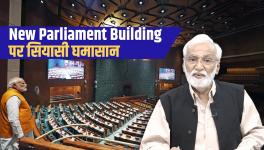Is GST Yet Another Misadventure by Narendra Modi?

Post demonetisation, an RBI study noted sharp fall in the sales and earnings of small companies with a turnover of less than Rs 25 crores. They had a fall of 57.6 per cent in sales and 122.3 per cent in EBIDTA (earnings before interest depreciation, taxation and amortisation) for the quarter ending March 2017; while big corporates with turnover of Rs 1,000 crore and above had 9.5 per cent rise in sales and 2.1 per cent increase in EBIDTA for the same period, reported Indian Express on August 27, 2017.
In the wake of GST implementation, profits of small companies plunged by 78 per cent amounting Rs 674 crores in the quarter ending June 2017, while companies with net sale of above Rs 100 crore posted cumulative profits in absolute values in the same quarter, said the same report. The real impact of GST can be assessed in the post GST quarter of FY2017-18.
The reports, however, do not speak on the huge job losses, particularly in unorganised sectors, due to demonetisation, digitalisation of money transactions and the GST.
Demonetisation with digitalisation of money transactions and GST are the two fiscal arms of Modi government’s neo-liberal economic drive. Both are dependent on digitalisation. This digital world is controlled by international corporates with alleged links with CIA and US army as revealed by WikiLeaks. It is not without a reason that Ambani is trying to control the digital space in India and Nandan Nilekani is back as chairman of Infosys after being the chairman of UIDAI of Aadhar and being the main architect of GSTN.
None can accuse the Congress party of lesser commitment to neoliberalism than Modi and BJP. GST was entirely designed, its ground was prepared and infrastructure was partially put in place by the Congress led Manmohan Singh government. BJP’s Modi government is aggressively implementing it. For, the theory of one religio-cultural nation of Hindutva and one common market for the foreign and domestic corporates are juxtaposed.
One core issue, related to GST, is about federalism and it is attacking the very foundations of the federal republic. Other core issues related to GST are discussed below.
From Informal to Formal Economy
The above data are indicative of a core issue in both the demonetisation with digitalisation and the GST, which is about the shift from informal to formal economy; small scale and informal sectors yielding market space to organised sector equipped with effective digital tools in one India market with consequent huge job losses particularly of workers in unorganised and household sectors.
The basic approach of GST is that all goods and services are taxable. Some may be outside it for the time being which may be included by the political executives in future. Some may have zero GST at present, yet these are in tax net. There is no further need of item by item budget proposal and approval on imposition of indirect taxes after scrutiny by the parliament and state assemblies. The board of political executives under their CEO, the union finance minister, in the GST Council will decide about imposition of indirect taxes on the people!
Another core issue is that GST’s tax base has been raised substantially, particularly for the central government. GST is destination-based and the rate is fixed at consumption stage. Earlier, the main central taxes were excise duties which were being collected at the manufacturing level. There is vast difference in ex-factory cost of a commodity and market price at consumption level. Therefore, there is huge difference in earlier central tax on ex-factory cost and now CGST part of the commodity at consumption price. In one jump, the central government has raised its indirect tax base of all commodities. Further, tax amount goes on increasing with the price rise of the commodity in the market. Instead of stopping price rise of commodities, the government linked itself with tax benefits with spiraling price rise.
Outsourcing and GSTN
The other core issue is about outsourcing of both central and state governments’ work. Thousands of employees’ jobs in the tax departments of both central and state governments have been outsourced to a private company – the GST Network (GSTN), created during Congress rule in March 2013 and adopted by Modi government as it is.
Thousands of employees were engaged in central and state indirect tax administration under different laws, regulations, procedures and formats. Those are now integrated and outsourced to GSTN for implementation. Entire collection, processing, compilation and dissemination work has been bestowed to GSTN interacting with tax payers, central and state governments and banks.
At present, the central government and state governments together hold 49 per cent shares of GSTN. 51 per cent are being held by five private companies including 10 per cent each of HDFC, HDFC Bank, ICICI Bank, NSE Strategic Investment Co; and LIC Housing Finance Ltd is having 11 per cent. It is important to note that FII’s share in each of these five companies rose from 30.68 per cent to 65.81 per cent as on August 4, 2017 which does not have any security clearance.
Being a private company, GSTN is outside CAG audit. GSTN refused to give access to its network to CAG saying it only was holding data in ‘fiduciary’ capacity. All tax data at present are available to CAG under the constitutional provision. The question remains unanswered even though CAG audited GSTN for being substantially funded by the central government for FY 2013-14, 2014-15 and 2015-16. CPI(M) Central Committee resolution on GST not only demanded auditing by CAG, but also demanded applicability of RTI on GSTN. Being a private company GSTN does not come under the RTI Act. But information about GSTN is essential under the RTI as major tax work is being carried out by GSTN for the central and state governments.
Attack on Social Security
Following global economic crisis, in the entire capitalist world there are serious attacks on the social security benefits of the workers and other toiling sections. In India, Modi government’s GST and Code on Social Security together pose a grave attack on the workers’ social security. The ground was prepared in 2016 itself. The Finance Act, 2016 abolished labour welfare cesses and from April 1, 2016 stopped their collection in mica mines, salt, merchant shipping, textiles, limestone and dolomite mines, tobacco, mines of iron ore, manganese ore and chrome ore; and of cine-workers. Rest of the cesses like construction and other workers welfare funds have been subsumed in the GST effective from July 1, 2017.
The proposed Code on Social Security by the Modi government, which is yet to be placed in the parliament, proposes abolition of all existing social security laws including Employees Provident Fund Act, ESI Act, Construction Workers Welfare Act etc to be replaced by the Code on Social Security. The Code proposes taking over by the government the entire accumulated fund of provident fund (which includes workers contribution also), ESI, construction workers welfare fund etc amounting to more than Rs 12 lakh crores. A committee will be constituted under the prime minister. Social security benefits, schemes for which are yet to be prepared, will be provided from this fund. Obviously, the government wants to invest this money in the share market and provide whatever social security scheme is made for the workers and others including old age pension etc from this fund.
Under these circumstances, peripheral changes in GST are not enough. The core issues need to be addressed. The struggle against GST is the struggle against neoliberalism.
Disclaimer: The views expressed here are the author's personal views, and do not necessarily represent the views of Newsclick.
Get the latest reports & analysis with people's perspective on Protests, movements & deep analytical videos, discussions of the current affairs in your Telegram app. Subscribe to NewsClick's Telegram channel & get Real-Time updates on stories, as they get published on our website.
























